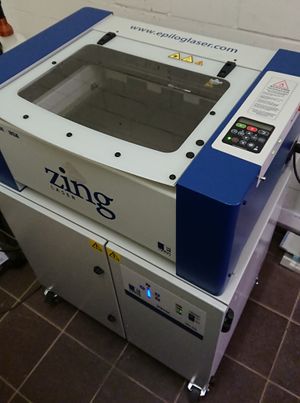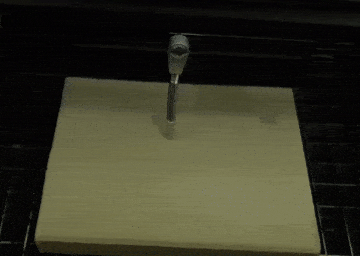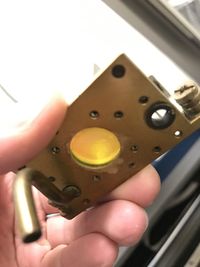Archived:Epilog Zing 16: Difference between revisions
NitramLegov (talk | contribs) m NitramLegov moved page (Archived) Epilog Zing 16 to Archived:Epilog Zing 16: Archived |
NitramLegov (talk | contribs) m extrabox in archive |
||
| Line 13: | Line 13: | ||
|manual=[https://www.epiloglaser.com/assets/downloads/manuals/zing-manual-web.pdf EpilogLaser.com (EN)] | |manual=[https://www.epiloglaser.com/assets/downloads/manuals/zing-manual-web.pdf EpilogLaser.com (EN)] | ||
|used with=[[Laser Exhaust System|laser exhaust system]] | |used with=[[Laser Exhaust System|laser exhaust system]] | ||
|extrabox=yes | |||
}} | }} | ||
Latest revision as of 15:19, 5 February 2024
These are some infos about a laser cutter we don't have anymore, but might still be interesting to others (e.g. users of the "Wanderlaser" in Verbund offener Werkstätten)
| MachineInfoBox Epilog Zing 16 | |
|---|---|

| |
| Synonyms: | DE: Laserschneider, "Lasercutter" |
| Material: | wood, glass, acrylic glass, ... (list of cuttable & engravable materials; list of only engravable materials) |
| Used with: | laser exhaust system |
| Access Requirements: | |
| Software: | VisiCut, Epilog printer driver, Corel Draw, any Windows software that can print |
| Manual: | EpilogLaser.com (EN) |
| Tutors: | |
Machine Control
Software
The Bachelor thesis on VisiCut gives a great overview on available software, we suggest using VisiCut itself but others may also work.
When accessing the laser, please note it currently uses 192.168.1.20 as its IP-Adress. You may have to enter this in the software, e.g. under "Hostname" in the laser cutter profile in VisiCut.
Confirmed to Work
- VisiCut (preferred) provides an Inkscape and Illustrator extension to directly import from these programs
- the official Epilog printer driver for Windows can cut with Corel Draw and Adobe Illustrator, but not with Inkscape
- raster engraving is possible with almost any Windows program that is capable to print
Other Options
- cups-epilog?
- ctrl-cut should work on Linux and Mac, used by Metalab Vienna
Control Pad/Manual Control
Detailed information on the different control pad functions can be found in the manual (pages 53ff).
Homing
The machine will home in a back corner every time it is turned on. It can also be re-homed while in the 'UnlockXY' mode ![]() by pressing the back button
by pressing the back button ![]()
Setting Zero Coordinate on the Workpiece
For setting the zero position it is good practice to turn on the pilot laser ![]() to see where the laser would cut. Afterwards disable the stepper motors by pressing (X/Y unlock [8])
to see where the laser would cut. Afterwards disable the stepper motors by pressing (X/Y unlock [8]) ![]() – now the mirror head can moved freely. Be aware to only apply light force on the metal parts, and do not touch the lens or mirror. Set the laser to the new zero position and press (Go)
– now the mirror head can moved freely. Be aware to only apply light force on the metal parts, and do not touch the lens or mirror. Set the laser to the new zero position and press (Go) ![]() . The stepper motors are now reengaged so do not try to move the head again.
. The stepper motors are now reengaged so do not try to move the head again.
In case the you want to cancel the XY positioning, it can be stopped by pressing the pause/stop ![]() .
.
Focusing

The laser cutter has a fixed focus from the head. In order to change the cutting point you have to move the workpiece by raising or lowering the Z-axis platform. Press (Focus [5]) ![]() (or (X/Y unlock [8])
(or (X/Y unlock [8]) ![]() ) – now the (Up)
) – now the (Up) ![]() and (Down)
and (Down) ![]() arrow buttons move the platform. The right distance to your cutting object can be measured with the focus gauge (spring which is usually kept folded up on the X axis by a magnet). Flip it down and move it over your workpiece, then raise the platform until the tip just touches down. Now the focus is directly on the surface of you object.
arrow buttons move the platform. The right distance to your cutting object can be measured with the focus gauge (spring which is usually kept folded up on the X axis by a magnet). Flip it down and move it over your workpiece, then raise the platform until the tip just touches down. Now the focus is directly on the surface of you object.
Note that for cutting, the focal point should ideally be within the workpiece! You can manually raise the platform a bit further after storing the focus gauge in its folded position again. Before you do that, it is a good idea to "zero" the determined workpiece surface level by pressing (Up) ![]() and (Down)
and (Down) ![]() simultaneously.
simultaneously.
Make sure that nothing sticks up far enough to touch any moving machine parts! Your workpiece should have a level surface or you are limited to only working on the high points.
Changing Job Settings
Speed and power settings for raster jobs can be changed, even during a job, by pressing (Speed [1]) ![]() or (Power [2])
or (Power [2]) ![]() .
.
Maintenance
Cleaning the Optics
The optics (two mirrors, the lens and the laser window) are cleaned with special optics cleaner or isopropanol or laboratory-grade acetone (NEVER ANYTHING ELSE!) every 2-3 operating days, using Q-tips in a rolling motion.

Lens
The lens is the last optical device in front of the object you are cutting and therefore it usually gets the dirtiest. Clean the lens with nothing but isopropanol and Q-tips by rolling the tip, NOT wiping. If the lens is quite dirty it usually takes 3-4 tips to clean it.
If you are not able to reach it well with a Q-tip, carefully screw it off and return it to its position after cleaning. Be aware that the thread is made of aluminum and should not be overtightened!
"Primary" Mirror
This mirror is just above the lens and will require an equal amount of cleaning compared to the lens. The process is similar to the lens.
"Secondary" Mirror & Laser Window
Every now and then, the mirror(s) on the left side of the Y axis might need to be cleaned using the same technique.
Cleaning the Rails
The rails the Y axis moves on (left and right side of the machine) should only be wiped with a dry lint-free cloth (or a bit of isopropanol/window cleaner).
Cleaning the Cutting Table
Until we have some experience ourselves, we'll stick with the RZL's procedure for cleaning the interior and the honeycomb table (wet wipes & oven cleaner not purchased yet).
Changing Filters
(main article: "Laser Exhaust System")
Laser Tube Replacement
The laser source itself will hopefully last 5 years before too much gas has diffused out of it and a noticable drop in power will occur. Tube replacement will be very expensive and will require careful calibration.